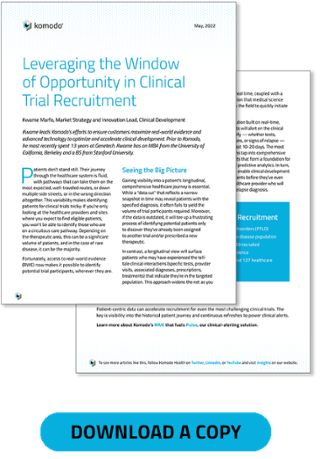Leveraging the Window of Opportunity in Clinical Trial Recruitment

Patients don’t stand still. Their journey through the healthcare system is fluid, with pathways that can take them on the most expected, well-traveled routes, down multiple side streets, or in the wrong direction altogether. This variability makes identifying patients for clinical trials tricky: If you’re only looking at the healthcare providers and sites where you expect to find eligible patients, you won’t be able to identify those who are on a circuitous care pathway. Depending on the therapeutic area, this can be a significant volume of patients, and in the case of rare diseases, it can be the majority.
Fortunately, access to real-world evidence (RWE) now makes it possible to identify potential trial participants, wherever they are.
Seeing the Big Picture
Gaining visibility into a patient’s longitudinal, comprehensive healthcare journey is essential. While a “data cut” that reflects a narrow snapshot in time may reveal patients with the specified diagnosis, it often fails to yield the volume of trial participants required. Moreover, if the data is outdated, it will tee up a frustrating process of identifying potential patients only to discover they’ve already been assigned to another trial and/or prescribed a new therapeutic.
 In contrast, a longitudinal view will surface patients who may have experienced the telltale clinical interactions (specific tests, provider visits, associated diagnoses, prescriptions, treatments) that indicate they’re in the targeted population. This approach widens the net as you identify patients not yet diagnosed but likely on a care pathway leading to diagnosis, enabling timely intervention. It also surfaces healthcare providers seeing a significant volume of your targeted population, i.e., potential collaborators you otherwise may have missed. Notably, these providers frequently practice in the community vs. traditional urban/academic settings, offering you the opportunity to expand your reach and facilitate more equitable access to new therapies.
In contrast, a longitudinal view will surface patients who may have experienced the telltale clinical interactions (specific tests, provider visits, associated diagnoses, prescriptions, treatments) that indicate they’re in the targeted population. This approach widens the net as you identify patients not yet diagnosed but likely on a care pathway leading to diagnosis, enabling timely intervention. It also surfaces healthcare providers seeing a significant volume of your targeted population, i.e., potential collaborators you otherwise may have missed. Notably, these providers frequently practice in the community vs. traditional urban/academic settings, offering you the opportunity to expand your reach and facilitate more equitable access to new therapies.
Timing is Everything
For many trials, there’s a narrow window of opportunity during which a patient is screening-eligible. This requires the data you’re using to be continuously updated to capture clinical interactions in near-real time, coupled with a clinical-alerting solution that medical science liaisons can access in the field to quickly initiate contact.
.png?width=900&name=BLOG-A%20window%20of%20opportunity-Image%20(1).png)
A clinical-alerting solution built on real-time, real-world touchpoints will alert on the clinical interactions you specify — whether tests, diagnoses, prescriptions, or signs of relapse — typically within the past 10-20 days. The most sophisticated solutions tap into comprehensive patient-centric insights that form a foundation for machine learning and predictive analytics. In turn, these advanced tools enable Clinical Development teams to identify patients before they’ve even engaged with the healthcare provider who will provide the initial or relapse diagnosis.
Let the Data Do the Work
Patient-centric data can accelerate recruitment for even the most challenging clinical trials. The key is visibility into the historical patient journey and continuous refreshes to power clinical alerts.
Learn more about Komodo’s  that fuels
that fuels  , our clinical-alerting solution.
, our clinical-alerting solution.
About the Author: Kwame leads Komodo’s efforts to ensure customers maximize real-world evidence and advanced technology to optimize and accelerate clinical development. Prior to Komodo, he most recently spent 13 years at Genetech. Kwame has an MBA from the University of California, Berkeley and a BS from Stanford University.
To see more articles like this, follow Komodo Health on Twitter, LinkedIn, or YouTube, and visit Insights on our website.





